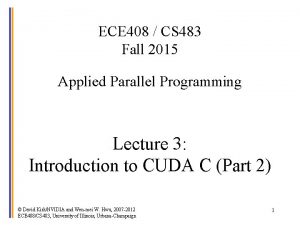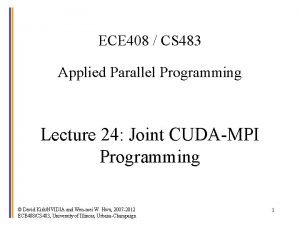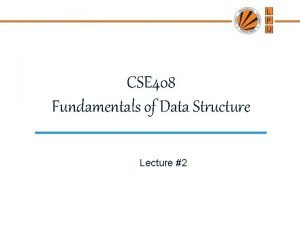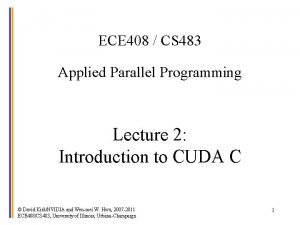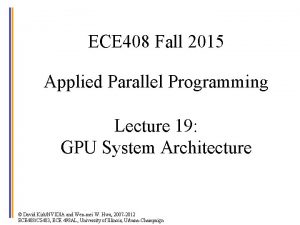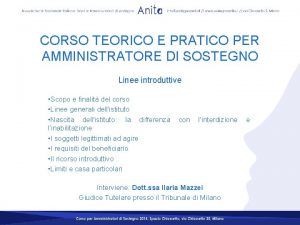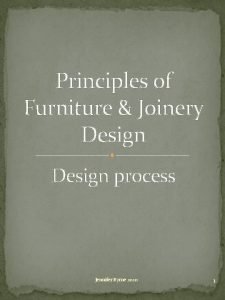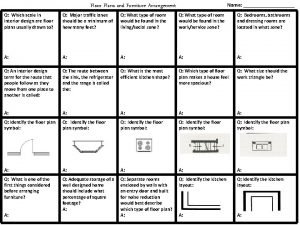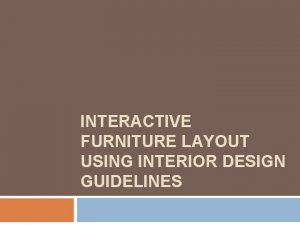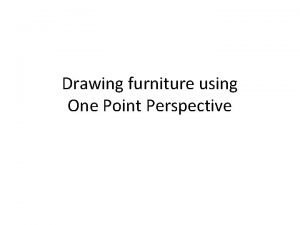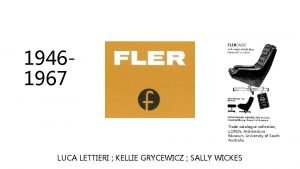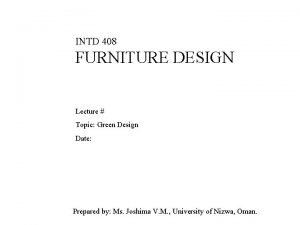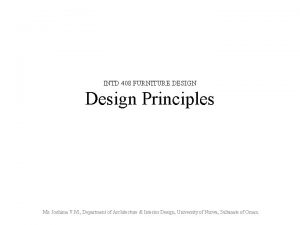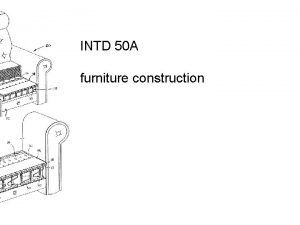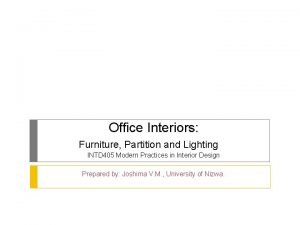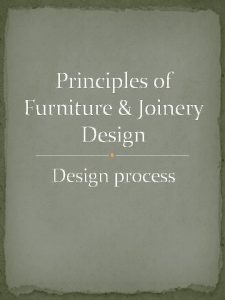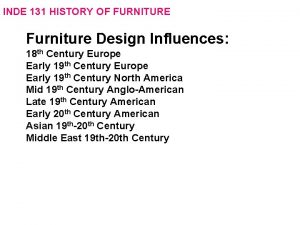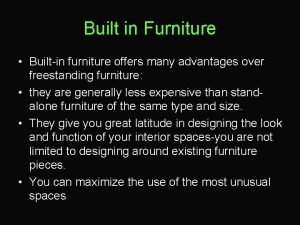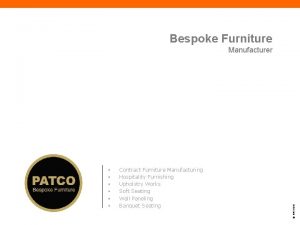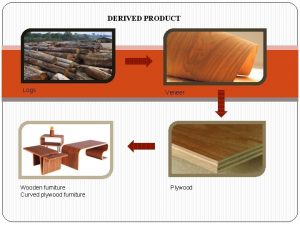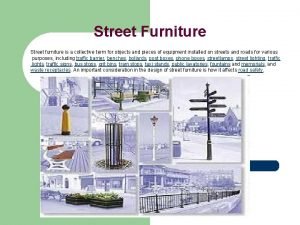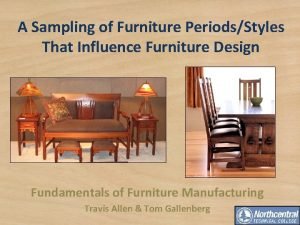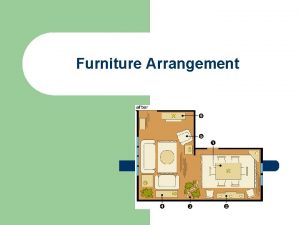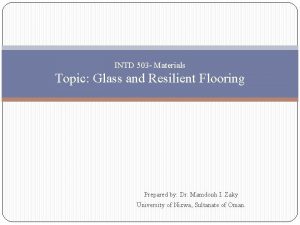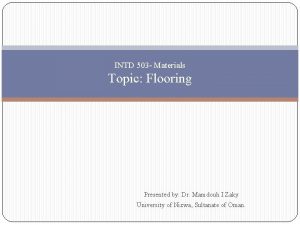INTD 408 FURNITURE DESIGN Topic Furniture Design Theory
































- Slides: 32

INTD 408 FURNITURE DESIGN Topic: Furniture Design Theory Prepared by: Ms. Joshima V. M. , University of Nizwa, Oman.

Design Theory • Theory is a set of statements or principlesdevised to explain a group of facts or phenomena - that guides action or assists understanding/judgment. • Design theories reveal knowledge - to help determine good designs and good design practices.

Design Theory • Design Knowledge and ethos change over time, and so do theory. • Today, theory engages aspects of: – Industrialization and Mass production – Green design – Health and welfare concerns – Universal design – Trans-generational design and – Social use

Design Theory • Theory becomes the conglomeration of many voices. – Lessons and ideas drawn from others are important things that can inspire and formulate personal views about furniture and design. • Mies van der Rohe said: “ A chair is a very difficult object. A sky scrapper is almost easier. ” – A chair is an extension of a user, where no two users are alike. – A chair is used for many different purposes. – Sitting is a challenge to a healthy body.

Design Theory • ‘ firmistas, utilitas and venustas’ which means firmness, commodity and delight is the framework on which the enquiry into furniture design theories are made.

Design Theory • Firmistas: structural integrity, tectonics and composition. – How furniture is made and held together? • Utilistas: use and experience. – How furniture functions and feels? • Venustas: form, spatial organization and aesthetics. – How furniture looks, fits within space and express meaning?

Firmistas/Firmness • Based on the Strength and Quality of furniture. • Means: Structural Integrity, Tectonic Composition • Achieved through: Fabrication techniques, quality of construction and spatial relationship among the parts and whole.

Firmistas/Firmness • Lateral forces, live loads and gravity should be carefully considered in the design of Furniture. • Lateral forces may cause joints and connections to fail. • Braces, skirts, folds and applied hardware serve to resist lateral forces. • Ideas are expressed through details. Workmanship, structural integrity and aesthetics are clarified through joinery.

Firmistas/Firmness Eg: Deck Chair by Erling Christoffersen and Borge Morgensen’s Windsor-type chair. The individual elements of Deck chair are flexible when unassembled, but when in use it becomes rigid. Windsor type chair is remarkable in its structural integrity and economy of its parts. Back spindles are placed in compression and curved outer member is in tension as pressure is applied to its back.

Utilistas/Commodity • Based on the Function and Feel of furniture. • Means Comfort, ergonomics, social use and tactile experience of furniture. • Achieved through: Knowledge on Human Factors (accessible design, anthropometrics, ergonomics, posture, proxemics and universal design).

Anthropometrics • Anthropometrics is the science of determining anatomical measurements and understanding the physiology of human body. • But it is not assumed that comfort is scientifically achieved by fitting the structure and movement of the body with furniture.

Ergonomics • Ergonomics concentrate to bring the performance of tasks within the limits of human body. • Focuses upon the study of work and how work is done. • Design solution seek to find a match between the measure and physiology of the body, tactile experiences of use and aspects of health, welfare and pleasure.

Ergonomics Ergonomic design of a chair considers to: • Support Body movements • Support Different body postures • Support Body weight evenly • Eliminate uncomfortable pressure points • Maintain lumbar lordosis

Posture • Furniture affects posture and influence how people sit, rest, work and gather. • Conversely observing how people naturally sit, work and rest can inspire design ideas.

Posture • Posture is a concept that says that human body is in continuous movement when sitting, standing or walking. • Body position is changed to seek comfort. • Posture expresses social- spatial communications between people, driven by culture and physiological factors.

Proxemics • Study of how people communicate/interact in different spaces.

Proxemics • It links the human behavior with social, cultural, spatial and geographic contexts. • Considers eye contact, body language, posture and social customs. • As well as intimate, personal, social and public spatial zones of interaction and communication. • Notions of privacy, intimacy, crowding, defensible space and territoriality are to be considered in the arrangement of furniture.

Proxemics. Social distances between people • In The Hidden Dimension, the author points out four categories of social dimensions: – Intimate distance for embracing, touching or whispering (15 – 45 cm) – Personal distance for interactions among good friends (0. 45 – 1. 2 m) – Social distance for interactions among acquaintances (1. 2 – 3. 6 m) – Public distance used for public speaking (over 3. 6 m)

Think about the differences!!

Venustas/Delight • Based on the Look of the furniture, spatial relation and meaning expressed. • Means: Form, spatial organization and aesthetics • Achieved through: Proportion, geometry, form, spatial placement &orientation, visual and tactile experience

Aesthetics • Aesthetics means sensitive especially by feeling. • Aesthetics is a branch of philosophy dealing with beauty, intervened with design principles.

Geometry • Geometry is the foundation of composition. • In order to conceive, design and draw furniture, one must have a technical or intuitive knowledge of the rules and principles of geometry.

Proportion • Proportion is derived from relationships within the human body and from relationships between door sizes, window sill height, room dimensions and so on. • Furniture should respond proportionally to the human body and to the interior space in which it is placed.

The golden section • Golden section is a ratio that results when a line is divided so that the short segment has the same relationship to the long segment that the long segment has to the sum of two parts. • It is a unique proportion of 1: 1. 6182 • This has influenced aesthetic theories for centuries. From renaissance to modernism.

Modernism • Modernism is a philosophical way of thinking about architecture and design. • Ideology encapsulated by ‘form follows function’. • Function and utility can and should create form.

Modernism The notion of function in modernism is affected by: • Intended purposes of the furniture- 10 20 & 30 • User of the furniture & Context of use • Fabrication method- tools, resources, energy and processes • Waste by-products • Societal or Economic impact • Methods of disposal, recycling or biodegrading

Systems Theory • Conceived furniture interrelated systems. as a network of eg. Physical , spatial, structural, electrical, mechanical systems. • Promoted an engineering and scientific approach to design. • Furniture were thought about as human body support machine. • More and more scientific researches were focused on the study of human body. But became less popular later.

Systems Theory

Built form and Culture/Vernacular • People from different cultural backgrounds view the built environment is different ways. • Culture is a reference frame to associate social meaning for furniture. • Primary consideration is humanist, societal and cultural perspectives. • Designs in relation to cultural context or regional context. • Influences the design, materials and fabrication.

Built form and Culture/Vernacular

New Formalismtheories of digital form • Digital software and digital machines started to affect our thinking about design. • Using digital platform to analyze or comprehend forms that complex in nature.

New Formalism
 Intd minor mcgill
Intd minor mcgill Ece 408 uiuc
Ece 408 uiuc Ece 408
Ece 408 Cse408
Cse408 Form 408b2
Form 408b2 Usace section 408
Usace section 408 Chapter 408 nyc doe
Chapter 408 nyc doe Ece 408
Ece 408 Cs 408 sabancı
Cs 408 sabancı Pub 408
Pub 408 Ece 408
Ece 408 Ece408
Ece408 Art 408 cc
Art 408 cc Map study in highway engineering
Map study in highway engineering Third person example
Third person example Research problem example for students
Research problem example for students Byrne custom woodworking
Byrne custom woodworking Flat pack furniture design
Flat pack furniture design Id design furniture
Id design furniture Topic design for project
Topic design for project Mfi furniture uk
Mfi furniture uk Papertainer museum
Papertainer museum Swot analysis of furniture business
Swot analysis of furniture business Floor plan arrangement
Floor plan arrangement Furniture industry south africa
Furniture industry south africa Furniture layout guidelines
Furniture layout guidelines Jacobean interior
Jacobean interior How to draw furniture in perspective
How to draw furniture in perspective Natural selection furniture
Natural selection furniture Carolean furniture
Carolean furniture Corcraft furniture
Corcraft furniture Corcraft furniture
Corcraft furniture Fler furniture catalogue
Fler furniture catalogue

